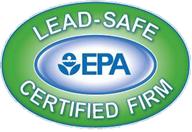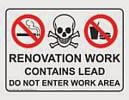Compliance With and Enforcement of the RRP Rule Will Be Assisted By OSHA Inspectors
 In addition to the OSHA rules contractors should already have been aware of related to worker safety, the EPA RRP rule has added yet additional OSHA concerns for renovators. One for example is working on a surface covered with plastic. OSHA considerations related to working on plastic are not part of the curriculum delivered during the required EPA certified renovator training. Due to the absence of this information, the EPA is essentially leaving it up to renovators to become aware of such considerations on their own. Once aware, renovators must seek out the information they need and adjust their work practices accordingly to avoid fines from OSHA should they get randomly inspected. Or worse, have a worker accident.
In addition to the OSHA rules contractors should already have been aware of related to worker safety, the EPA RRP rule has added yet additional OSHA concerns for renovators. One for example is working on a surface covered with plastic. OSHA considerations related to working on plastic are not part of the curriculum delivered during the required EPA certified renovator training. Due to the absence of this information, the EPA is essentially leaving it up to renovators to become aware of such considerations on their own. Once aware, renovators must seek out the information they need and adjust their work practices accordingly to avoid fines from OSHA should they get randomly inspected. Or worse, have a worker accident.
 This begs a few questions. First, were the authors ignorant of such considerations? Asked another way, does the left hand know what the right hand is doing? Is this another example of a breakdown in communication between very significant departments of our government charged to look out for our best interests? A second question might be; did the authors of the EPA RRP rule leave this information out of the rule for a strategic purpose? Perhaps this is just one more way to force small independent businesses out of the construction industry in favor or labor unions.
This begs a few questions. First, were the authors ignorant of such considerations? Asked another way, does the left hand know what the right hand is doing? Is this another example of a breakdown in communication between very significant departments of our government charged to look out for our best interests? A second question might be; did the authors of the EPA RRP rule leave this information out of the rule for a strategic purpose? Perhaps this is just one more way to force small independent businesses out of the construction industry in favor or labor unions.
In one of his recent blogs, RRP certification training provider and business coach, Mark Paskell of The Contractor Coaching Partnership, shares a real life story about a contractor who was visited, at the same time, by both an OSHA inspector as well as an inspector from the Massachusetts Department of Occupational Safety (DOS). (Massachusetts has assumed administration and enforcement of the RRP rule from EOPA) In the blog Mark describes the battle that took place between the OSHA inspector and the DOS inspector about the use of plastic on the jobsite. Check out the blog to see which inspector retreated.
 Of bigger concern should be the distribution of misinformation at the certified renovator training. For example, using the sample signage included in the EPA approved training manual (required to be posted outside contained work areas), might just get you in trouble with OSHA. First off the RRP rule requires the use of a “warning” sign, but the sample sign is a “caution” sign. OSHA considers a warning sign to be a stronger message than a caution sign, and has rules dictating when and how to choose one versus the other.
Of bigger concern should be the distribution of misinformation at the certified renovator training. For example, using the sample signage included in the EPA approved training manual (required to be posted outside contained work areas), might just get you in trouble with OSHA. First off the RRP rule requires the use of a “warning” sign, but the sample sign is a “caution” sign. OSHA considers a warning sign to be a stronger message than a caution sign, and has rules dictating when and how to choose one versus the other.
Also, if you have employees, the sample sign in the manual will not meet OSHA requirements either. Employees must be told what they are being warned about on such signs, in this case lead, and the signs must also instruct the employees not to smoke, eat, or drink in a work area assumed to contain lead. Check out this article by Dick Hughes of Excellence in Safety for a list of other OSHA requirements left out of the RRP rule.
The RRP is challenging enough to comply with. Contractors putting their heads in the sand about OSHA requirements and compliance are taking a huge risk. I am planning on taking some OSHA training classes to learn more about what contractors must need to be aware of and what they will need to do to avoid risking violations and fines. I will post information about this subject to RRPedia in the future. If you have not done so already, you can subscribe to RRPedia at the top of this page. Subscribers will be notified by e-mail as soon as new articles are posted.
If you are looking for forms and signage to help you with comply with the EPA RRP rule, I recommend you check out what The Lead Paint Forms Store has to offer.
 Many liability insurance policies do not cover lead poisoning or contamination. Renovators should be sure they are working with an agent who is up on the EPA RRP rule and should sit down with their agent to review their coverage needs and options. Tom Messier, with Mason and Mason Insurance, tells me that insurance companies are starting to become aware of the RRP rule. Insurance is all about risk. The greater the risk, the higher the cost of insurance will be.
Many liability insurance policies do not cover lead poisoning or contamination. Renovators should be sure they are working with an agent who is up on the EPA RRP rule and should sit down with their agent to review their coverage needs and options. Tom Messier, with Mason and Mason Insurance, tells me that insurance companies are starting to become aware of the RRP rule. Insurance is all about risk. The greater the risk, the higher the cost of insurance will be.
 Looking for accurate information about the EPA RRP rule?
Looking for accurate information about the EPA RRP rule?  Increased risk of liability due to lead awareness as well as the government mandated certification requirements are likely to affect a renovator’s ability to get a policy as well as the premium charged by carriers who offer coverage. Tom told me he predicts that existing policies will not be renewed unless a renovator can show they are certified firms and use certified renovators to oversee the work their company performs. He also predicts insurance carriers will start requiring the insured’s proof of compliance with the rule as well as proof of compliance and insurance coverage for the trade partners the insured renovator works with. Tom stressed that this would be for both liability as well as workers compensation insurance coverages. He said that even if they are self-employed, insurance carriers will likely require all trade partners have their own workers compensation policies as a way to prevent injured or poisoned trade partners from claiming against the general contractor’s policy.
Increased risk of liability due to lead awareness as well as the government mandated certification requirements are likely to affect a renovator’s ability to get a policy as well as the premium charged by carriers who offer coverage. Tom told me he predicts that existing policies will not be renewed unless a renovator can show they are certified firms and use certified renovators to oversee the work their company performs. He also predicts insurance carriers will start requiring the insured’s proof of compliance with the rule as well as proof of compliance and insurance coverage for the trade partners the insured renovator works with. Tom stressed that this would be for both liability as well as workers compensation insurance coverages. He said that even if they are self-employed, insurance carriers will likely require all trade partners have their own workers compensation policies as a way to prevent injured or poisoned trade partners from claiming against the general contractor’s policy.  One other area that will likely be of concern is lead coverage in policies for landlords who own pre-1978 properties. Here too, compliance with RRP rules and documentation of work practices used for renovations and repairs will likely become required conditions of obtaining and keeping coverage. The EPA RRP rule may also cause an increase in insurance coverage on properties built prior to 1978, for landlords and maybe even home owners.
One other area that will likely be of concern is lead coverage in policies for landlords who own pre-1978 properties. Here too, compliance with RRP rules and documentation of work practices used for renovations and repairs will likely become required conditions of obtaining and keeping coverage. The EPA RRP rule may also cause an increase in insurance coverage on properties built prior to 1978, for landlords and maybe even home owners.
 Second, the warning signs and barriers required to be put in place around exterior and common area containment areas will have a similar effect of raising concern. Unless properly educated about their options and about lead-safe work practices, neighbors and the parents of children attending child occupied facilities will again suffer from ignorance about lead. Many will likely react out of fear. This fear may potentially result in reporting a renovator and causing an inspection, even if the renovation work is being done within compliance.
Second, the warning signs and barriers required to be put in place around exterior and common area containment areas will have a similar effect of raising concern. Unless properly educated about their options and about lead-safe work practices, neighbors and the parents of children attending child occupied facilities will again suffer from ignorance about lead. Many will likely react out of fear. This fear may potentially result in reporting a renovator and causing an inspection, even if the renovation work is being done within compliance.  Remember, as a business you are guilty until you prove yourself innocent at your own expense. An OSHA and or RRP inspector will likely be able to find at least one violation of some rule if they show up at one of your jobsites. Some inspectors may even feel it is their obligation to find a violation. The cost to defend yourself might be as high as the cost of any fines, so even if you win you lose. In Massachusetts, the Department of Occupational Safety (DOS) is already collaborating with OSHA regarding what to do if either finds a violation that should be referred to the other. Oh, and don’t forget those neighbors who have a bone to pick with your customer, have nothing else to do all day, and or are just plain paranoid.
Remember, as a business you are guilty until you prove yourself innocent at your own expense. An OSHA and or RRP inspector will likely be able to find at least one violation of some rule if they show up at one of your jobsites. Some inspectors may even feel it is their obligation to find a violation. The cost to defend yourself might be as high as the cost of any fines, so even if you win you lose. In Massachusetts, the Department of Occupational Safety (DOS) is already collaborating with OSHA regarding what to do if either finds a violation that should be referred to the other. Oh, and don’t forget those neighbors who have a bone to pick with your customer, have nothing else to do all day, and or are just plain paranoid. In addition to the OSHA rules contractors should already have been aware of related to worker safety, the EPA RRP rule has added yet additional OSHA concerns for renovators. One for example is working on a surface covered with plastic. OSHA considerations related to working on plastic are not part of the curriculum delivered during the required EPA certified renovator training. Due to the absence of this information, the EPA is essentially leaving it up to renovators to become aware of such considerations on their own. Once aware, renovators must seek out the information they need and adjust their work practices accordingly to avoid fines from OSHA should they get randomly inspected. Or worse, have a worker accident.
In addition to the OSHA rules contractors should already have been aware of related to worker safety, the EPA RRP rule has added yet additional OSHA concerns for renovators. One for example is working on a surface covered with plastic. OSHA considerations related to working on plastic are not part of the curriculum delivered during the required EPA certified renovator training. Due to the absence of this information, the EPA is essentially leaving it up to renovators to become aware of such considerations on their own. Once aware, renovators must seek out the information they need and adjust their work practices accordingly to avoid fines from OSHA should they get randomly inspected. Or worse, have a worker accident.  This begs a few questions. First, were the authors ignorant of such considerations? Asked another way, does the left hand know what the right hand is doing? Is this another example of a breakdown in communication between very significant departments of our government charged to look out for our best interests? A second question might be; did the authors of the EPA RRP rule leave this information out of the rule for a strategic purpose? Perhaps this is just one more way to force small independent businesses out of the construction industry in favor or labor unions.
This begs a few questions. First, were the authors ignorant of such considerations? Asked another way, does the left hand know what the right hand is doing? Is this another example of a breakdown in communication between very significant departments of our government charged to look out for our best interests? A second question might be; did the authors of the EPA RRP rule leave this information out of the rule for a strategic purpose? Perhaps this is just one more way to force small independent businesses out of the construction industry in favor or labor unions.  Of bigger concern should be the distribution of misinformation at the certified renovator training. For example, using the sample signage included in the EPA approved training manual (required to be posted outside contained work areas), might just get you in trouble with OSHA. First off the RRP rule requires the use of a “warning” sign, but the sample sign is a “caution” sign. OSHA considers a warning sign to be a stronger message than a caution sign, and has rules dictating when and how to choose one versus the other.
Of bigger concern should be the distribution of misinformation at the certified renovator training. For example, using the sample signage included in the EPA approved training manual (required to be posted outside contained work areas), might just get you in trouble with OSHA. First off the RRP rule requires the use of a “warning” sign, but the sample sign is a “caution” sign. OSHA considers a warning sign to be a stronger message than a caution sign, and has rules dictating when and how to choose one versus the other.  Variances in the rule requirements, from the EPA RRP rule and also from state to state, will make it difficult for renovators to understand the differences and keep up with amendments made by each entity. Renovators working in more than one state many have to become certified firms in each state they operate in and or also with the EPA. Are renovators better off if their states write a better thought out rule? Would renovators be better served if there was just one well written rule for everyone to follow? I predict that confusion may likely contribute to violations and fines for these renovators.
Variances in the rule requirements, from the EPA RRP rule and also from state to state, will make it difficult for renovators to understand the differences and keep up with amendments made by each entity. Renovators working in more than one state many have to become certified firms in each state they operate in and or also with the EPA. Are renovators better off if their states write a better thought out rule? Would renovators be better served if there was just one well written rule for everyone to follow? I predict that confusion may likely contribute to violations and fines for these renovators.  In July of this year Massachusetts took over administration and enforcement of the RRP rule.
In July of this year Massachusetts took over administration and enforcement of the RRP rule.  The MA DOS has also started conducting on-site inspections. Though most inspections are triggered by citizens reporting suspected violations, the DOS is also out in the field and is stopping by renovation projects as they come across them. In one of his recent blogs, RRP certification training provider and business coach, Mark Paskell of The Contractor Coaching Partnership, shares a
The MA DOS has also started conducting on-site inspections. Though most inspections are triggered by citizens reporting suspected violations, the DOS is also out in the field and is stopping by renovation projects as they come across them. In one of his recent blogs, RRP certification training provider and business coach, Mark Paskell of The Contractor Coaching Partnership, shares a 


